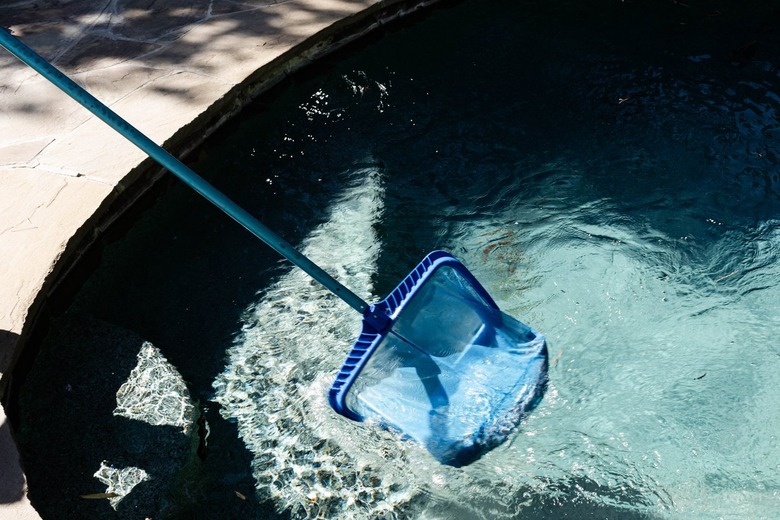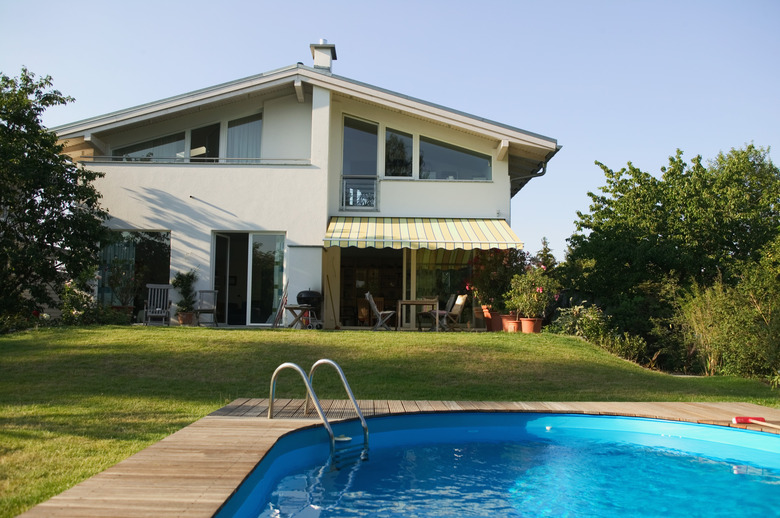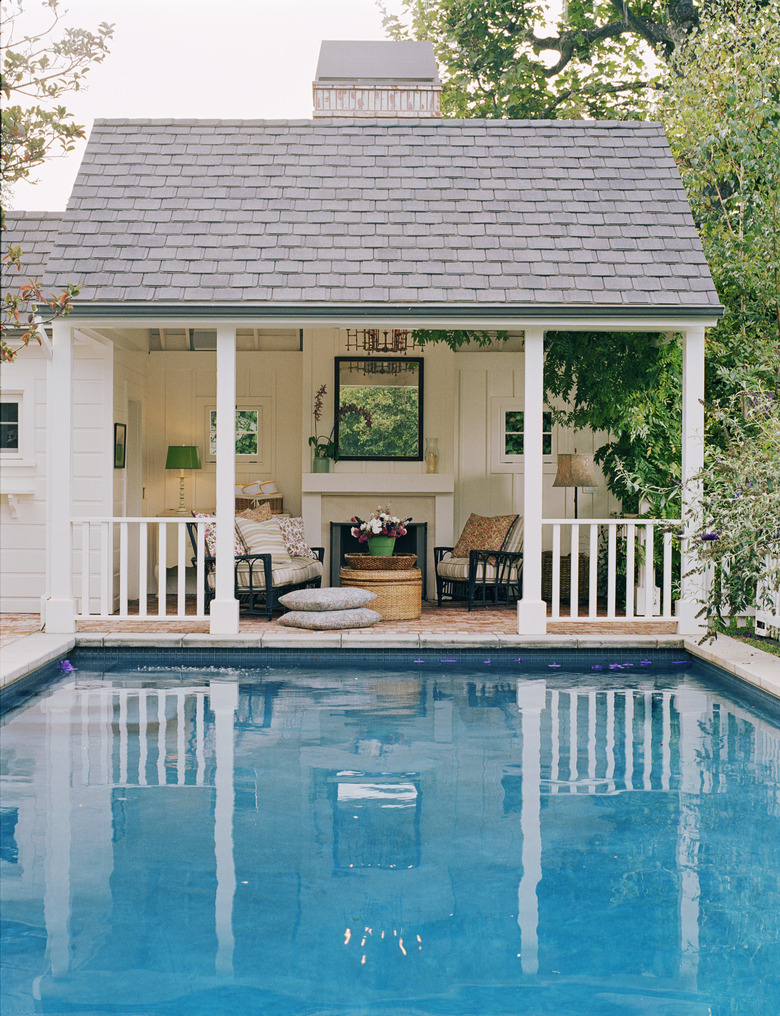Year-Round Swimming Pool Maintenance Schedule
Owning an in-ground or large above-ground swimming pool means a summer of swimming, playing in the water, hosting parties and just plain relaxing, but as any pool owner will tell you, pools require attention, and the best way to keep the water clean and pleasant is to follow a pool maintenance schedule. A pool maintenance schedule can be divided into three parts. There's the pool opening, the routine periodic maintenance to keep the pool and water clean and finally, there's the pool closing to get the pool through the winter. Most pool care tasks are the same for both in-ground and large above-ground pools.
Opening Your Swimming Pool
Opening Your Swimming Pool
A lot happens during a pool opening but don't be overwhelmed. You can always call in a pool service company to handle the tasks you would rather avoid, such as removing and cleaning the cover. However, if you are eager to do the job yourself, you should know when the best time to open it is and what supplies you'll need to get it done.
Many people wait until swimming weather hits their area before opening their swimming pool, but it is a good idea to start your pool maintenance schedule before that when the temperature is consistently above 70 degrees Fahrenheit. While that's too cold to take a dip, it is warm enough for algae to grow and pollen to settle in the pool, especially if you have a mesh pool cover. Running the pool water through the filter at this stage can reduce both and can prevent cleanup headaches later.
First, remove the cover, clean it and let it dry. Then, fold it and store it for the summer. Clean off and retract automatic retractable covers. For an above-ground pool, you may want to keep the cover handy so that you can cover the pool if you will be away for an extended period. Check for any damage to the pool, such as torn vinyl liners, cracks, broken tiles and the like.
Remove anything floating in the water. Bring the water up to its proper level, which is usually the middle of the skimmers. Remove any winterizing plugs from the inlets and outlets in the pool.
Brush the sides of the pool using a pool brush and vacuum the bottom of the pool. Make sure the pump and filter are in good condition, including performing any manufacturer-recommended maintenance. Then, run the filter for about 24 hours before doing anything else.
Swimming Pool Chemistry
Swimming Pool Chemistry
Get the pool water ready for the summer by making sure it is in balance, which means that certain components of your pool are all in acceptable ranges. If they are not, the sanitizer you use to remove harmful contaminants, such as chlorine, won't be effective. When your pool is being opened after a long winter, the water may look dirty, may be a strange color or may just be unappealing in general.
Before you open the pool, test for total alkalinity, pH levels, calcium hardness, total dissolved solids, stabilizers and sanitizers. In most cases, the sanitizer is chlorine, and the stabilizer protects the chlorine from being broken down by the ultraviolet rays of the sun. Total dissolved solids (TDS) are everything that has dissolved in your pool water. These include trace minerals in the water you used to fill the pool and byproducts of pool chemicals. TDS levels are seldom a problem at the pool opening because the water you added will dilute the amount present. However, levels should be watched as the season goes on.
You can take a sample of the water to a pool supply store for testing, or you can do the test yourself. DIY test kits provide information on a number of components in the water, and tests often list the acceptable ranges of the components that will give you clean, crystal-clear water.
Water that has overwintered in your pool is rarely perfect, and you will more than likely need to add products that balance the water, such as pH increasers and calcium-hardness adjusters, which are sold at swimming pool supply stores. In most cases, once you've adjusted the other components, you will shock the water with a high dose of chlorine.
Tip
Note that if your pool has a saltwater chlorine generator, do not turn on the chlorine generator until you've run the filter and balanced the water. Then, if chlorine levels remain low, add shock to the water. Then, turn on the generator. The device should keep chlorine levels consistent, or it will signal when you need to add more pool salt.
Daily Swimming Pool Maintenance
Daily Swimming Pool Maintenance
Daily maintenance might not be necessary, but there are things you should do every time someone uses the pool. The first is to simply note the water level. Pool water evaporates and gets splashed out of the pool often during raucous pool hangs (especially ones that involve games of chicken). Make sure the water is at the right level so that the pump can pull the water through the skimmers. Running a pump dry will damage it.
Use a long-handled skimmer — which in this case is a big net and not the device that connects the pool water to the filtration system — to remove floating debris from the pool. You want to catch leaves, grass clippings and the like before they sink because once they are on the bottom, they are harder to remove and can stain the pool liner.
Make sure the pump is running if someone is swimming. Even if no one is using the pool, it's a good idea to run the pump eight to 12 hours per day. Many people believe that it is the chemicals they add that clean the water, but the pump and filter help distribute the chemicals, and they play a large part in overall swimming pool cleanliness.
Run the pool vacuum every few days. There are a number of automatic vacuums that operate on their own. Some use electricity to move around, while others rely on the pool's filtration system for propulsion.
Weekly Swimming Pool Maintenance
Weekly Swimming Pool Maintenance
It should become a weekly ritual to test and balance the water like you did when you opened the pool. The people who swim in the pool, the leaves and other debris that land in the pool, sunlight, the breakdown of the sanitizer and even rain can all affect the quality and clarity of the pool water. It is also a good idea to test the chlorine level after a heavy rainstorm or a pool party where a lot of people used the pool. Those conditions usually call for shocking the water.
The pool's wall skimmers for both in-ground and above-ground pools and the pump contain baskets and strainers to catch large debris. Make it a part of your pool maintenance schedule to check and clean them at least once a week. Strainers that are full can make the pump work harder than necessary, possibly damaging the motor.
While you are working around the filter, check its pressure gauge. Filters have an operating pressure measured in pounds per square inch (PSI). When the pressure increases about 10 PSI above its normal operating pressure, which varies from filter to filter, it is time to clean the filter for peak performance. Filters usually don't require cleaning every week, but it is important to keep an eye on the pressure.
Brush the pool's walls and floor with a pool brush. This helps prevent algae formation. Brush the ladders and diving board as well.
Monthly Swimming Pool Maintenance
Monthly Swimming Pool Maintenance
Manufacturers recommend cleaning the pool's filter once a month during the swimming season as part of your pool maintenance schedule, but that is just a guideline. If the pressure rises, clean the filter more often.
There are three types of swimming pool filters: cartridge, sand and diatomaceous earth (DE). A DE filter consists of fossilized algae-like organisms that coat a grid inside the filter housing. Sand filters use the sharp edges of particles of sand to filter out impurities. Cartridge filters look like pleated air filters.
Always follow the manufacturer's directions for filter maintenance, but in general, cartridge filters can be removed from their housing and hosed off. Sand and DE filters can be backwashed to clean the filtering medium. The directions for backwashing are usually printed right on the filter housing and in the manual that came with the filter, but it generally goes like this: Turn a knob or handle on the filter, which will reverse the flow of water to clean the filter medium. Turn it back to start regular filtration. It is a simple process, but there are a few things of which to be aware.
Always shut off the pump before each stage of the backwashing process. You will need to safely dispose of the backwashed water as it contains chemicals that can harm plants. You can pipe it to a dry well or connect a hose to the filter and divert the water to a drain. Unlike sand filters, DE filters need to be replenished after backwashing. The DE powder is simply poured into a skimmer, where it makes its way to the pool filter to coat the grids.
For pool safety, it's also a good idea to inspect such things as the nuts and bolts on pool ladders and diving boards monthly. Be sure to inspect the fence surrounding the pool as well, including the required self-latching gate that leads to the pool area.
Closing the Swimming Pool
Closing the Swimming Pool
A pool closing can be just as detailed as an opening. A closing that leaves the water clean and ready for the winter and that protects the equipment will make the opening next season that much easier.
Wait until the air temperature is consistently below 65 degrees Fahrenheit before closing the pool. The lower temperatures help prevent algae from forming. So, even if you are not using the pool, keep up with the regular maintenance until closing. Give the pool walls and floor one last cleaning and vacuuming.
You should then test and balance the water. Water that will sit in your pool all winter often requires other chemicals, such as algaecides and those that remove or suspend metals that may be in the water. Metals that sit in your pool water all winter can lead to stains on the pool's surfaces. You can get advice on what you may need at a pool supply store. There are pool closing kits that contain the necessary additives.
The day before you plan on disconnecting the filter, shock the water and run the filter overnight. Then, lower the water level. The water helps support the cover, so consult the cover manufacturer on how much to lower the water.
Backwash and clean the filter. Then, disconnect it per the manufacturer's directions. For above-ground pools, most filters and pumps are disconnected and stored inside. Blow out the pool's plumbing lines with compressed air. (Note that you may want to hire a pro for this step.)
There are products that help compensate for freezing pool water. For above-ground pools, pool pillows are inflatable bladders that float under the cover. When the water freezes, the pillow compresses, relieving the stress on the sides of the pool. For in-ground pools, there are devices that are screwed into skimmers to protect them from ice damage.
For saltwater pools, be sure to remove the salt cell from the chlorine generator and store it per the manufacturer's directions. Cut the power to heaters and other devices. Store vacuums and other equipment indoors for the winter. The last step is to put the cover in place.


